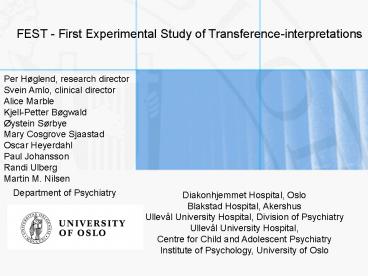PowerPointpresentasjon PowerPoint PPT Presentation
1 / 19
Title: PowerPointpresentasjon
1
FEST - First Experimental Study of
Transference-interpretations
Per Høglend, research director Svein Amlo,
clinical director Alice Marble Kjell-Petter
Bøgwald Øystein Sørbye Mary Cosgrove
Sjaastad Oscar Heyerdahl Paul Johansson Randi
Ulberg Martin M. Nilsen
Department of Psychiatry
Diakonhjemmet Hospital, Oslo Blakstad Hospital,
Akershus Ullevål University Hospital, Division of
Psychiatry Ullevål University Hospital, Centre
for Child and Adolescent Psychiatry Institute of
Psychology, University of Oslo
2
The Famous Dora Case
3
Psychodynamic interpretation
- So we see that you avoid talking about this
- DEFENCE
because you feel anxious and uncomfortable
ANXIETY
discussing your sadness and anger over
IMPULSE
your fathers death.
PARENTS
You did the same after your divorce
OTHERS
and again now that we are ending therapy
THERAPIST
Defence Anxiety
Parents Others
Impulse
Therapist
4
Psychoanalytically oriented psychotherapy
5
Outcome measures specific to psychodynamic
psychotherapy
6
Psychodynamic Functioning Scales ( PFS)
- Quality of Family relationships 1 -
100 - Quality of Friendships
1 - 100 - Quality of Romantic Relations 1 -
100 - Tolerance for Affects
1 - 100 - Insight
1 - 100 - Problem solving Capacity
1 - 100 - Overal Psychodynamic Functioning is the simple
weighted average of the six scales. - Reliability for average scores of three expert
raters - status scores 0.91
- change scores( relative interpretation) 0.82
- change scores (absolute interpretation) 0.94
7
Hypotheses
- Patients treated with transference
interpretations (transference group) will have
better long-term effects than patients treated
without transference interpretations (comparison
group) on the two primary outcome measures, the
Psychodynamic Functioning Scales (PFS) and
Inventory of Interpersonal Problems (IIP). - Patients with more mature object relations ( high
QOR) and/or without personality disorders will do
better with transference interpretations.
8
Pretreatment characteristics of patients who
received dynamic psycho-therapy of one year
duration with (N52) and without (N48)
transference interpretations.
- Transference Comparison
- 38 (9)
36 (10) - 61 (14)
69 (13)
- 8 (2)
8 (2) - 5.4 (0.6)
5.4 (0.6) - 5.1 (0.8)
5.1 (0.8) - 50
63 - 38
54 - 50
52 - 26
23 - 14
17 - 17
19 - 44
46 - 19
19
- Age
- Global optimism
- Expectancy
- Motivation
- Quality of Object relations
- Female sex
- Single
- Depressive disorders
- Anxiety disorders
- Other
- No diagnosis
- Personality disorders
- More than one pers.dis.
9
Quality of Object Relations
- Lifelong pattern of relationships from primitive
to mature - 7-8 Mature equitable relationships
- 5-6 Recent relationships may be difficult, but
there are evidence of at least one mature
relationship in the patients history - 3-4Need of dependency or overcontrol in most
relationships - 1-2 Unstable, less gratifying relationships
10
Specific Techniques
- 1.Therapist addresses transactions in the
patient-therapist relationship - 2. Therapist encourages exploration of thoughts
and feelings about the therapy and the therapist - 3 .The therapist encourages the patient to
discuss how the therapist might feel or think
about the patient - 4. The therapist explicitely includes himself in
interpretive linking of dynamic elements
(conflicts), direct manifestations of
transference, allusions to the transference, and
repercussions on transference by high therapist
activity - 5. The therapist interprets repetitive
interpersonal patterns, including genetic
interpretations, and links to transference
11
Treatment integrity (Sessions rated 447)
- Transference Comparison
- 1.7 (0.7) 0.1 (0.2)
- 2.4 (0.4) 2.7 (0.3)
- 0.7 (0.3) 0.7 (0.3)
- 3.6 (.0.2) 3.6 (0.3)
- Trans. interpretations (5 items)
- Extra-transference interpr. (5 items)
- Supportive (7 items)
- General skill (8 items)
Scale format No emphasis Minor
Moderate Considerable Major emphasis
0 1 2
3 4
T
C
12
Follow-up period 3 years
- Transference
Comparison - Additional psychotherapy 14 (27)
16 (33) - Antidepressants 11 (22)
16 (33) - Sick leave 6
(12) 14 (29) - Positive lifeevents 3,7
4,0 - Negative lifeevents 2,6
2,5 - Attrition at 1 year follow-up 0
6 - Attrition at 3 year follow-up 0
0
13
Main effect of transference interpretations
- TRANSFERENCE
COMPARISON -
N 52 N
48 - PFS
- Pretreatment 62.9 (4.6)
63.3 (5.2) - Posttreatment 69.7 (5.8)
69.4 (6.8) - 1 year follow-up 70.5
(5.4) 69.8 (5.7) - 3 years follow-up 72.0
(6.3) 71.5 (6.1) - IIP
- Pretreatment 1.17 (0.5)
1.14 (0.5) - Midtreatment 1.19 (0.5)
1.12 (0.5) - Posttreatment 1.02 (0.6)
0.89 (0.5) - 1 year follow-up 0.91
(0.6) 0.86 (0.5) - 3 years follow-up 0.80
(0.6) 0.79 (0.5)
14
(No Transcript)
15
Figure 2. Descriptive mean trajectories for
transference group and comparison group within
the high QOR subsample and the low QOR subsample.
74
72
70
68
PFS
66
Transference low QOR
64
Comparison low QOR
Transference high QOR
Comparison high QOR
62
60
Pre-treatment
Post-treatment
3 years follow-up
1 year follow-up
Time
16
QOR centered at average level in the low QOR
subsample
17
(No Transcript)
18
Follow-up period 3 yearsLow QOR subsample (N44)
- Transference
Comparison - N25
N19 - Antidepressant medication 5 (20)
5 (26) - Additional psychother. 5 (20)
10 (52) - gt11 sess 3
2 - Any mental health treatm. 7 (28)
11 (58) - Hospitalized 0 (0 )
5 (26) - Sick leave 3 (12)
7 (37) - Negative
life events (4 years period) - Pre-treatment 5,7
4,8 - Post-treatment 4,1
2,0 - One year follow up 2,4
3,1 - Three years Follow-up 2,8
4,3
19
Within-group correlations
- High QOR Transference group (N26)
- PFS
IIP GAF GSI - Early transference
- interpretations 0.30
0.12 0.18 0.35 - Low QOR Transference goup (N24)
- Early transference
- interpretations -0.40
-0.17 -0.29 -0.03

